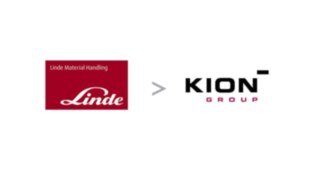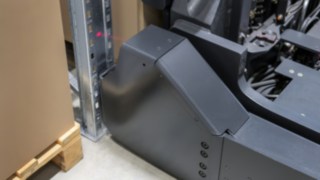
Rack protection and mast control revisited
28 Jan 2021
Innovative equipment options for Linde reach trucks
A sensor that prevents collision damage to the rack and a multifunction lever that ensures efficient control of driving, reach travel and lifting functions while being gentle on the finger joints: These two new options are now available for reach trucks from Linde Material Handling. Fleet managers benefit from cost savings and productivity gains, while forklift drivers can devote their full attention to goods handling.
Collision damage to racking systems is a major annoyance for warehouse managers because it can entail considerable expenditure of time and money. Crushed rack supports and damaged pillars primarily result from operators of reach trucks maneuvering in front of the rack with their eyes looking upward as the load is stored and retrieved. “What’s happening on the ground can easily slip out of focus,” says Alexander Schmidt, Senior Product Manager Reach Trucks at Linde Material Handling, adding that market studies have shown that damage is caused primarily by the load arms while the load, forks or chassis are less frequently involved. “Even minor carelessness can lead to major obstructions in warehouse operations,” Schmidt says. “If a rack frame is dented six millimeters over a length of one meter, up to one-third of the rack’s load-carrying capacity can be lost. This might mean that the corresponding number of rack locations can no longer be occupied and the capacity of the warehouse is consequently reduced. Repairing the damage and replacing the broken rack support is time-consuming because all areas to the right and left of the damaged rack frame must be emptied and the goods temporarily stored elsewhere. This takes up working time and additional storage space, disrupts operations and thus reduces productivity in the warehouse,” the Senior Product Manager says, outlining the negative consequences.
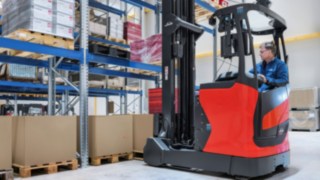
The Rack Protection Sensor (RPS) for reach trucks from Linde Material Handling detects objects that come into focus in the light beam in front of them. If an obstacle is identified, the assistance system dynamically brakes the truck, thus avoiding damage.

The Rack Protection Sensor (RPS) for reach trucks from Linde Material Handling detects objects that come into focus in the light beam in front of them. If an obstacle is identified, the assistance system dynamically brakes the truck, thus avoiding damage.
Linde Material Handling is addressing this problem by means of its Rack Protection Sensor (RPS). Two special light sensors, which are installed above the load arms in a protected housing, detect objects that come into focus in the light beam in front of them. If an obstacle is identified, the assistance system dynamically brakes the truck, thus avoiding damage. The sensors become active at a driving speed of less than five kilometers per hour – which is the usual speed when maneuvering in front of a rack. If operators accelerate the vehicle above this set limit, for example to cover longer distances, the patented system automatically switches off. The technology is particularly well suited to the conditions in the warehouse because it can work in artificial light as well as in daylight and sunlight, explains Schmidt.

The Rack Protection Sensor for reach trucks from Linde Material Handling supports the fast yet safe maneuvering of goods as an “additional eye at ground level”.

The Rack Protection Sensor for reach trucks from Linde Material Handling supports the fast yet safe maneuvering of goods as an “additional eye at ground level”.
The RPS has proven particularly helpful for companies whose driver pool regularly includes new or temporary employees. “These individuals often lack experience and misjudge the dimensions of the reach truck,” states the Linde product manager. Here, as an “additional eye at ground level”, the RPS provides valuable support for the fast yet safe maneuvering of heavy equipment.
The RPS assistance system is available as optional equipment for the high-performance models of reach truck series Linde R14 - R25 with a load capacity of 1.4 to 2.5 tons and will soon also be offered as a retrofit solution for these trucks.
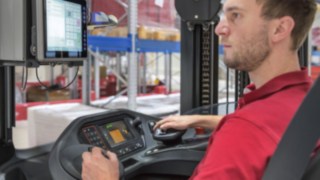
A new type of multifunction lever makes operating the Linde reach trucks even more comfortable. All hydraulic functions are combined in a single control element and there is no need to move the hand up and down.

A new type of multifunction lever makes operating the Linde reach trucks even more comfortable. All hydraulic functions are combined in a single control element and there is no need to move the hand up and down.
The second new option from goods handling specialist Linde MH is a new type of multifunction lever. It makes operating the Linde reach trucks even more comfortable and is designed to help maintain the concentration and health of drivers as well as increase productivity. Based on an ergonomic study, the innovative human machine interface was developed in collaboration with the Fraunhofer Institute (IAO) and Porsche Industriedesign. The result is a joystick that can be easily operated and moved in all four directions, with the operator’s curved hand resting comfortably in a natural position. A wing extended laterally to the right provides additional support for hands of any size. The driving, reach travel and lifting functions can be controlled intuitively with minimal effort from the wrist and fingers. All hydraulic functions are combined in a single control element and there is no need to move the hand up and down. This results in increased productivity and enables intuitive operation. The entire lever is moved back and forth to raise or lower the lift mast. Movements to the left and right direct the reach travel of the mast.
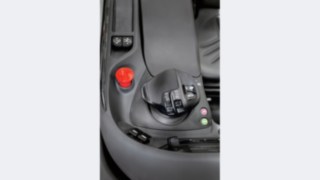
Optionally available for controlling of reach trucks from Linde Material Handling is a new type of multifunction lever. It integrates raising and lowering of the lift mast, fork carriage tilt and sideshift as well as the horn and the direction lever.

Optionally available for controlling of reach trucks from Linde Material Handling is a new type of multifunction lever. It integrates raising and lowering of the lift mast, fork carriage tilt and sideshift as well as the horn and the direction lever.
Repositioned from the armrest to the center of the large joystick, the two butterfly levers for controlling the fork carriage tilt and sideshift now combine two additional functions: They also serve to control the tilt and horizontal leveling of the fork carriage as well as the alignment and centering of the sideshift, respectively. The horn and the direction lever are located on the left side of the multifunction lever. A major advantage of the conveniently arranged components is that all control commands can be executed intuitively, even when wearing gloves, so that the driver's attention remains focused on the load handling at all times.

